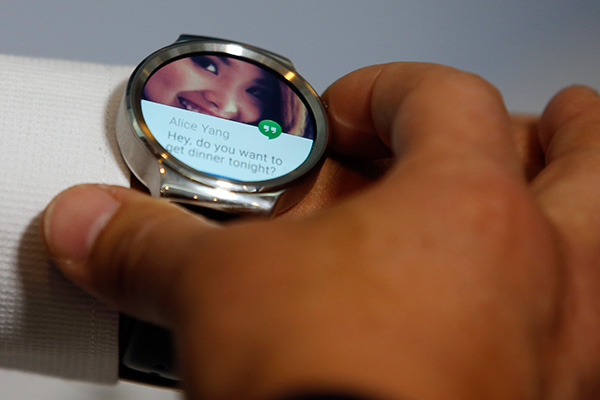
Huawei Watch on display during the Mobile World Congress in Barcelona. On March 3, 2015, Chinese telecom equipment maker Huawei launched its first smartwatch, a round-faced device that works with Android phones, joining a crowded market weeks before the introduction of the highly anticipated Apple Watch. (Photo/China Daily)
It is also proving exceptional good business for the tech companies looking for the next big product.
Data released by consultancy firm iResearch in Beijing showed that the total shipment of wearable devices, including smart watches and bands will top 40 million by the end of this year, an expected jump of 128 percent compared to 2014. By the end of next year, the number is poised to increase by 85 percent to 75 million.
Already the Chinese wearables market is predicted to hit 11.49 billion yuan ($1.8 billion) by the end of this year, and will grow another 47 percent to 16.94 billion yuan ($2.7 billion) by 2016, according to iResearch.
"By catering to individual demands with this technology, we are seeing a new niche developing with massive opportunities," Rust said.
Figures released by Global Systems for Mobile Communications Alliance, an industry body, showed that wearable child tracking devices are helping fuel strong demand here. Telecoms operator China Mobile has estimated that there are up to 50 child tracker bands on the market.
But this is not the only area of growth. A survey from the Consumer Electronics Association in the US reported that 67 percent of Chinese consumers used wearable smart watches or bands to monitor their fitness. Nielsen has come up with similar findings.
"Today there is a huge emphasis on aesthetics and design in technology, while health is an increasingly important topic for today's Chinese consumers," Rust said.
"By creating an outstanding consumer experience that focuses on these attributes, wearable tech will enjoy high growth in the near future."
Low prices have helped fuel sales of fitness smart bands. They use sensors that count the number of steps a person wearing a device has taken before relaying that information to a smartphone app.
Xiaomi's sales success can be largely attributed to that. The company's fitness bands retail at just 79 yuan each.


















































